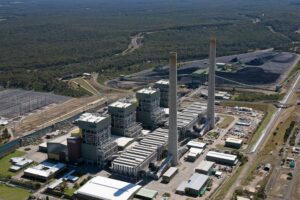When Liberal Senator James Paterson was asked on ABC TV’s Q&A on Monday night when the federal Coalition government would accept “once and for all, that the energy system has to change, and start to lead that change rather than standing in the way of it,” his response was essentially: technology will do the job for us.
“I’m really positive about technological change and evolution, and I’m really positive that the innovation that we’re already seeing, and that we’re going to see over the next few years is going to help us meet the challenge of climate change,” the Victorian Senator said in response to the audience question, which happened to come from The Australia Institute economist Jim Sandford.
When will your government accept that our energy system has to change? @SenPaterson responds #QandA https://t.co/hEdd2eEAHs
— ABC Q&A (@QandA) November 7, 2016
“I think, for example, that Tesla, the electric car, is a wonderful innovation and a really exciting thing and the sooner that that is commercial viable and can be adopted on a wide scale, the better,” Paterson added.
It’s a familiar refrain from the Turnbull government’s “innovation nation” songbook. And it is almost always followed up with a disclaimer along the lines of: but we can’t rush the shift to renewable energy technology, because costs and jobs and economic impact.

But there is a big hole in this logic, in that it relies on technology keeping the same slow-and-steady pace as federal government policy. And as a new report from global credit ratings agency Fitch Ratings has neatly illustrated, that’s not the way things are shaping up.
The report, Disruptive Technology: Batteries, notes that one of the key technologies that will be a major factor in how quickly the energy transition unfolds is already on the fast-track – and showing serious potential to “displace current technology far more rapidly than anticipated.”
And this leaves all sorts of industries – particularly those centred around the extraction and burning of fossil fuels, and the jobs attached to those industries – exposed to huge risk.
“Greatly accelerated adoption of battery technology would be disruptive for sectors accounting for just under a quarter – $US3.4 trillion – of corporate bonds outstanding globally,” the report notes.
“An acceleration of the electrification of transport infrastructure would be resoundingly negative for the oil sector’s credit profile,” the report says. “And it could change the economics of ‘peaker’ power plants currently used to meet short periods of peak loads.”
As the report notes, these “peaking” plants have traditionally been gas, and oil fired, with the ability to ramp up and down relatively quickly to meet changing loads.

“These units may dispatch infrequently in some markets but may be economic due to high peak power prices that offset maintenance costs for upkeep,” it says.
“‘Peak shaving’ resulting from battery storage of energy would reduce the peak to off-peak price differential and could eventually lower clearing prices to a point where traditional peakers can no longer compete. Mitigating grid reliability concerns will be the main focus of battery technology but the possibility of disruption among peakers is high.”
For Australia, this has serious implications not just for the nation’s gas peaker plants, but for its LNG industry, which as Forbes oil market analyst Tim Daiss reported on Monday, is already on shaky ground having undergone a project development frenzy based on “what looked like would be years of increased demand amid exorbitantly high prices.”
This includes the massive Wheatstone LNG project, on the Western Australian coast, whose estimated output of the 8.9 million tons per annum (mtpa) have been valued at $A29 billion.
Already, thanks to an oversupplied market and collapsing demand in Asia – oh, and climate change – these projects are looking more and more like overpriced carbon bombs. Add to that the existential threat from battery storage and the picture looks even worse.
But the fallout doesn’t stop there. “For electric utilities and the automotive sector it would be disruptive, potentially polarising the market into winners and losers,” the Fitch report says.
In Australia, we have seen this play out to some degree already, with last week’s news about the March 2017 closure of Victoria’s Hazelwood coal power plant; and then the launch of that other exciting Tesla product, the Powerwall 2 home battery storage system, which has effectively doubled in capacity while halving in cost, all in little more than nine months.

Meanwhile, says the report, most forecasts – including those favoured by the Turnbull government – assume incremental improvements in battery and other renewable technologies, “which still leaves significant room for fossil fuels.”
This gradual change, the Fitch analysts write, allows companies – and governments – to slowly adapt and monetise most of their investments to date.
“But the possibility remains for more rapid improvements.”
Meanwhile, in Australia, the Turnbull government seems determined to put up as many speed humps to progress as it can, in efforts to prolong the energy status quo.
As fellow Q&A panellist Naomi Klein pointed out, this not only looks like a “middle finger to the world” in terms of the Paris climate pact, it also puts Australia embarrassingly behind the pace of technology, and at odds with the world’s leading innovators, in whom our government is placing so much faith.
“You raised the Tesla,” Klein said to Paterson. “Just yesterday there was a piece, quoting Elon Musk, inventor of the Tesla, saying we need a popular uprising against fossil fuels. I can’t do it alone… It isn’t enough just to invest in the new technology, we need that, but we also have to stand up to the extraordinary power of coal, oil and gas.”









